
Content:The word " brother " in the Russian language is used not only to refer to biological relatives, but also to refer to members of a group with close social ties. So the same root word “ brotherhood ” means a community of people with common interests, views and beliefs [1] [2], the English analogue of the Russian brotherhood - “ brother hood ” also has a common root with the word “ brother ” - brother [3] similarly in in French, the brotherhood is con frér ie , the brother is frère , and even in Indonesian, per saudara an is saudara . Can this universal pattern indicate that such a social phenomenon as “brotherhood” has direct biological roots? I suggest a little deeper into the topic and see how the evolutionary-biological approach can give a deeper understanding of social phenomena.
1.Ameba heroes and bee volunteers are examples of altruism in nature.
2. Self-sacrifice by calculation - the theory of kinship selection and the Hamilton rule.
3. Brotherly love and disgust - Taiwanese marriages and Jewish kibbutzim.
4. The amygdala of discord - the neuroimaging of racial prejudice.
5. Fake kinship - real cooperation - Tibetan monks and guest workers.
6. Inhumans. Dehumanization - propaganda, empathy and aggression.
7. What's next? - In conclusion, why all this is very important.
[1] en.wiktionary.org/wiki/fraternity
[2] www.ozhegov.org/words/2217.shtml
[3] dictionary.cambridge.org/dictionary/english/brotherhood?q=Brotherhood
Amoeba Heroes and Bee Volunteers
Kinship, as a rule, implies an increased level of altruism. Altruism, as self-sacrifice and willingness to sacrifice one’s own interests for the benefit of others, is certainly one of the most outstanding human qualities, or not only human ones?
As it turned out, animals are also quite capable of showing altruism, including many insects living in colonies [4]. Some monkeys give an alarm to their relatives at the sight of predators, while at the same time endangering themselves. In beehives there are individuals that do not reproduce themselves, but only look after their offspring all their lives [5] [6], and amoebae of the dictyostelium (Dictyostelium discoideum) species sacrifice themselves upon the onset of adverse conditions for the colony, forming a stem on which their relatives rise above the surface and get the opportunity to travel as spores to a more favorable environment [7].

Examples of altruism in the animal kingdom. Left: the fruiting body in the mold mucosa of Dictyostelium discoideum (photo by Owen Gilbert). Center: brood from ant Myrmica scabrinodis (photo by David Nash). Right: care for offspring of long-tailed tits (photo by Andrew MacColl). Source: [6]
[4] www.journals.uchicago.edu/doi/10.1086/406755
[5] plato.stanford.edu/entries/altruism-biological
[6] www.cell.com/current-biology/fulltext/S0960-9822 (06) 01695-2
[7] www.nature.com/articles/35050087
Calculation of self-sacrifice
Okay primates, but self-sacrifice in insects and unicellular? Something is wrong here! - the Darwinist of the beginning of the last century would exclaim. Indeed, risking for the sake of another, an individual reduces its chance to produce offspring, and, following the classical theory of selection, such behavior should not undergo selection.
All this made the adherents of Darwinian natural selection seriously nervous, until, in 1932, John Haldane, the rising superstar of evolutionary biology, noticed that altruism could be fixed if it was aimed at relatives, and formulated this principle, which became later catch phrase [8]:
“I would give my life for two siblings, well, or eight cousins.”Hinting that siblings are genetically 50% identical, and cousins only 12.5%. So thanks to the work of Haldane, the foundation for a new “synthetic theory of evolution” began to be laid, the protagonist of which is no longer an individual, but genes and populations.
Indeed, if the ultimate goal of the body is to spread its genes, then it makes sense to increase the chances of reproduction of those individuals that have more common genes with you. Based on these data and inspired by statistics, William Hamilton in 1964 formulated a rule called the Hamilton rule later [9], which states that altruistic behavior between individuals is possible only when the ratio of their common genes is multiplied by an increase in the probability of gene transfer , for the individual to whom altruism is directed, there will be more than an increase in the risk of not transferring their genes to the individual who performs the act of altruism, which in its simplest form can be written as:
Where:
r (relatedness) - the proportion of common genes between individuals, e.g. for siblings ½,
B (benefit) - an increase in the probability of reproduction of the second individual in the case of altruism of the first,
C (cost) - reduction in the probability of reproduction of an individual performing an altruistic action.
And this model has repeatedly been confirmed in observations [10] [11]. For example, in a study conducted by biologists from Canada [12], for 19 years they tracked a population of red squirrels (a total of about 54,785 individuals in 2,230 litters), and recorded all cases when proteins feeding their offspring adopted squirrels whose mothers died.
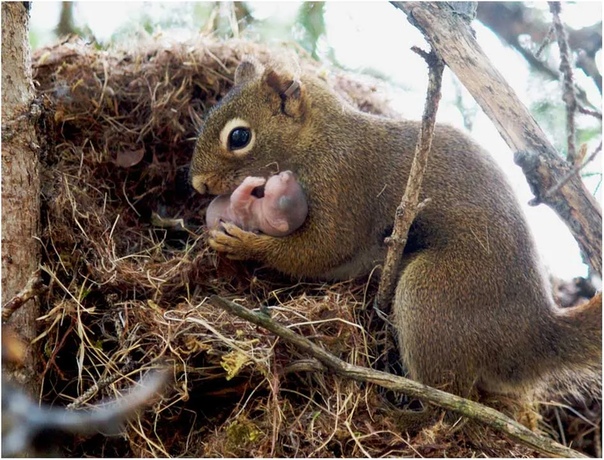
A female red squirrel is preparing to move a newborn between the nests. Source [12]
For each case, the degree of kinship and risk for their own offspring were calculated, then, having compiled a table with these data, the scientists found that the Hamilton rule is respected to the third decimal place.

Lines A1 through A5 correspond to cases when female siblings adopted other people's children; lines NA1 and NA2 correspond to cases when adoption did not occur; in the column “Inclusive fitness of adopting one juvenile”, the calculation according to the Hamilton formula for each of the cases is given. Source [12]
[8] www.goodreads.com/author/quotes/13264692.J_B_S_HaldaneAs you can see, the recognition of relatives is an important factor in the selection and this is confirmed by a wide variety of mechanisms for such recognition, because to understand with whom you have more common genes is important not only to determine who is more beneficial to show altruism, but also to avoid sexual contact with closely related individuals (inbreeding), because the offspring obtained as a result of such relations is weaker. For example, it was confirmed that animals can recognize relatives by smell [13], using the main histocompatibility complex [14], birds by singing [15], and primates with the help of facial features can even recognize those of their relatives with whom they never not met [16].
[9] http://www.uvm.edu/pdodds/files/papers/others/1964/hamilton1964a.pdf
[10] www.nature.com/articles/ncomms1939
[11] www.pnas.org/content/115/8/1860
[12] www.nature.com/articles/ncomms1022
[13] www.ncbi.nlm.nih.gov/pmc/articles/PMC2148465
[14] www.ncbi.nlm.nih.gov/pmc/articles/PMC3479794
[15] www.nature.com/articles/nature03522
[16] www.ncbi.nlm.nih.gov/pmc/articles/PMC4137972
Brotherly love and disgust
People are still more interesting and more complicated. A research team from the School of Psychology at the University of Aberdeen published in 2010 interesting results of a study [17] of how 156 women aged 17 to 35 evaluated photographs of faces of various men. At the same time, scientists secretly mixed images of faces of artificially created from the photos of the subjects themselves to ordinary photos of random people, as if it were a sibling, that is, with a 50% difference.

Examples of constructing self-similar persons from the study. The 50% difference in the artificial face was used, as if it were the sibling of the subject Source [17].
The results of the study showed that women often rated self-similar persons as trustworthy, and at the same time less sexually attractive. At the same time, similar faces of those women who had real brothers or sisters were least attracted. This speaks in favor of the fact that the perception of kinship in humans as well as in animals can stimulate cooperation on the one hand and at the same time help to avoid inbreeding.
There is also evidence that non-relatives may begin to perceive each other as relatives under certain conditions. At the beginning of the 19th century, the Finnish sociologist Westermark, studying the sexual behavior of people, suggested that the mechanism for determining a relative can work on the principle of capturing. That is, people will perceive each other as relatives and be disgusted by the thought of having sex, provided that in the early stages of life they were in close contact for a long time, for example, brought up together [18] [19].
We give the most striking examples of observations that support the sealing hypothesis. Thus, at the beginning of the 20th century, kibbutzim - agricultural communes numbering several hundred people began to gain popularity in Israel, and along with the abandonment of private property and the equality of consumption, children in such communities almost from birth were brought up together, which allowed adults devote even more time to work. Statistics of more than 2700 marriages of people who grew up in such kibbutz showed that between those who were brought up in the same group during the first 6 years of life, marriages were practically absent [20].

A group of children in the kibbutz Gan Shmuel, circa 1935-40. Source en.wikipedia.org/wiki/Westermarck_effect
Similar patterns were observed in Taiwan, where until recently there was a practice of Sim-pua marriages (translated as “little bride”), when the bride was adopted at the age of 4, the bridegroom's family was born, after which the future spouses were brought up together. The statistics of such marriages showed that they were 20% more likely to commit adultery, there were three times as many divorces, and such marriages accounted for a quarter fewer children born [21].
[17] www.ncbi.nlm.nih.gov/pmc/articles/PMC3136321
[18] archive.org/details/historyhumanmar05westgoog
[19] academic.oup.com/beheco/article/24/4/842/220309
[20] Incest. A biosocial view. By J. Shepher. New York: Academic Press. 1983.
[21] www.sciencedirect.com/science/article/abs/pii/S1090513808001189
Tonsil of discord
It would be logical to assume the evolutionary usefulness of the mechanisms for determining not only “ours” but also “aliens”. And just as the definition of kinship plays an important role in cooperation and altruism, so the definition of a stranger plays an important role in the manifestation of fear and aggression. And in order to better understand these mechanisms, we will have to plunge a little into the fascinating world of neuropsychological research.
There is a small but very important paired structure in our brains, the amygdala, which plays a key role in emotions, especially negative ones, in remembering emotional experiences and in triggering aggressive behavior.
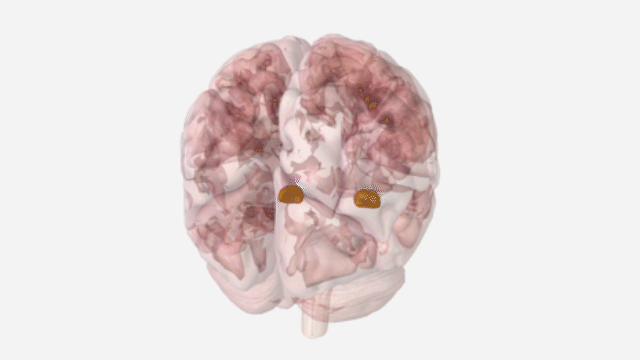
The location of the tonsils in the brain is highlighted in yellow, source human.biodigital.com
Tonsil activity is highest when making emotional decisions and actions in stressful situations. When activated, the tonsil suppresses the activity of the prefrontal cortex [22] - our center for planning and self-control. At the same time, it was shown that people whose prefrontal cortex is better able to suppress tonsil activity may be less susceptible to stress and post-traumatic disorder [23].
An experiment in 2017, with the participation of people who committed violent crimes, showed that in the process of passing a specially designed game, people who committed violent crimes provoking an opponent in the game often provoked an aggressive response and the activity of their tonsils recorded using the fMRI device was significantly higher than that of the control group [24].
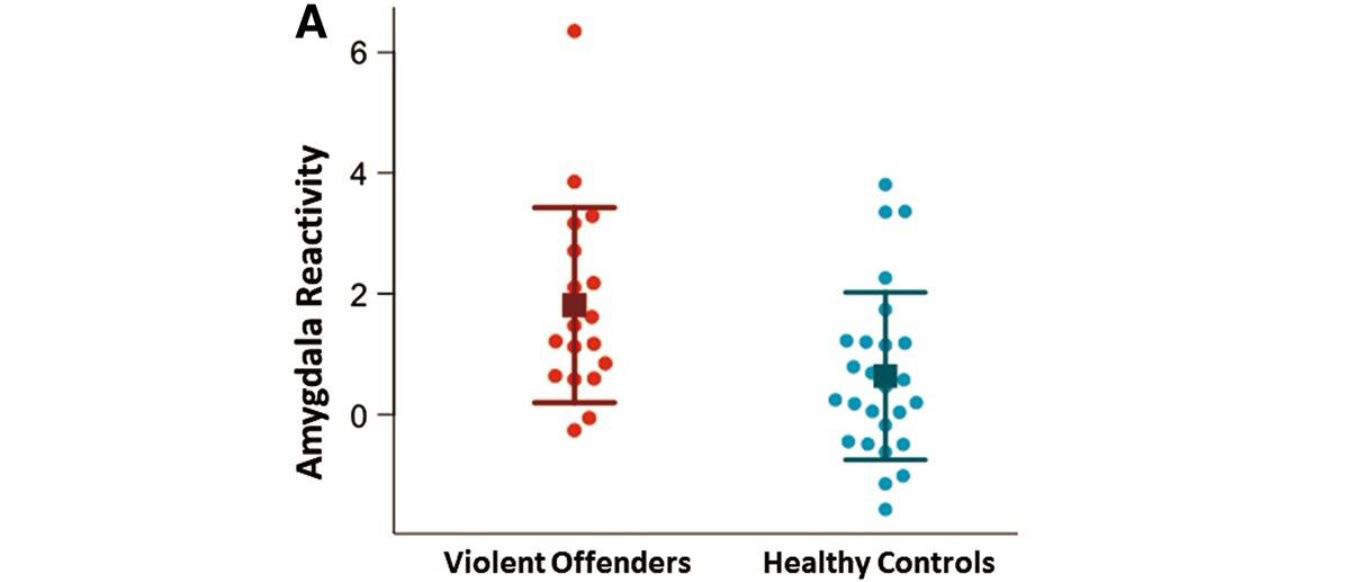
“Amygdala reactivity” - signal values extracted from the left and right tonsils of the subjects. Violent criminals (red dots) show a higher reactivity of the tonsils to provocations (P = 0.02). [24]
A classic study showed that tonsil activity intensified when viewing photographs of people of a different race and correlated with the results of the Implicit Association Test on racial bias [25]. Further study of this topic revealed that the effect of activation on the faces of another race was enhanced if the image was presented in a subthreshold mode for perception for a period of about 30 milliseconds. That is, even when a person did not have time to realize what exactly he saw, his tonsil already signaled danger [26].
The opposite effect was observed in cases when, in addition to the image of a person’s face, information was presented about his personal qualities. The researchers placed the subjects in the fMRI apparatus and observed the activity of brain regions when performing two types of tasks, the subjects were presented with a visual stimulus in the form of random people of the European and African races, and they needed to answer a question about this person, for example, is he friendly, lazy or unforgettable . At the same time, along with the photograph, additional information was also presented, in the first case not relating to the person’s personality, and in the second, some information about this person, for example, that he grows vegetables in the garden or forgets clothes in a laundry machine.

Examples of tasks that participants in the study solved. Within 3 s, the participants made a personal judgment indicating “yes” or “no” on the image of the person’s face (white or black man) and the information segment under the image. In the case of “superficial” judgments, the information segments were not personifying. In the model of “personal” judgments, the information was personified and described the unique properties and qualities of the goal. Thus, the participants were given the opportunity to either individualize the image of the face or not. Source [27]
The results showed a great activity of the tonsils, with answers when it was necessary to make a superficial judgment, that is, when information not relating to the personality was presented. In personal judgments, tonsil activity was lower and, at the same time, sections of the cerebral cortex that were responsible for modeling the personality of another person were activated [27].
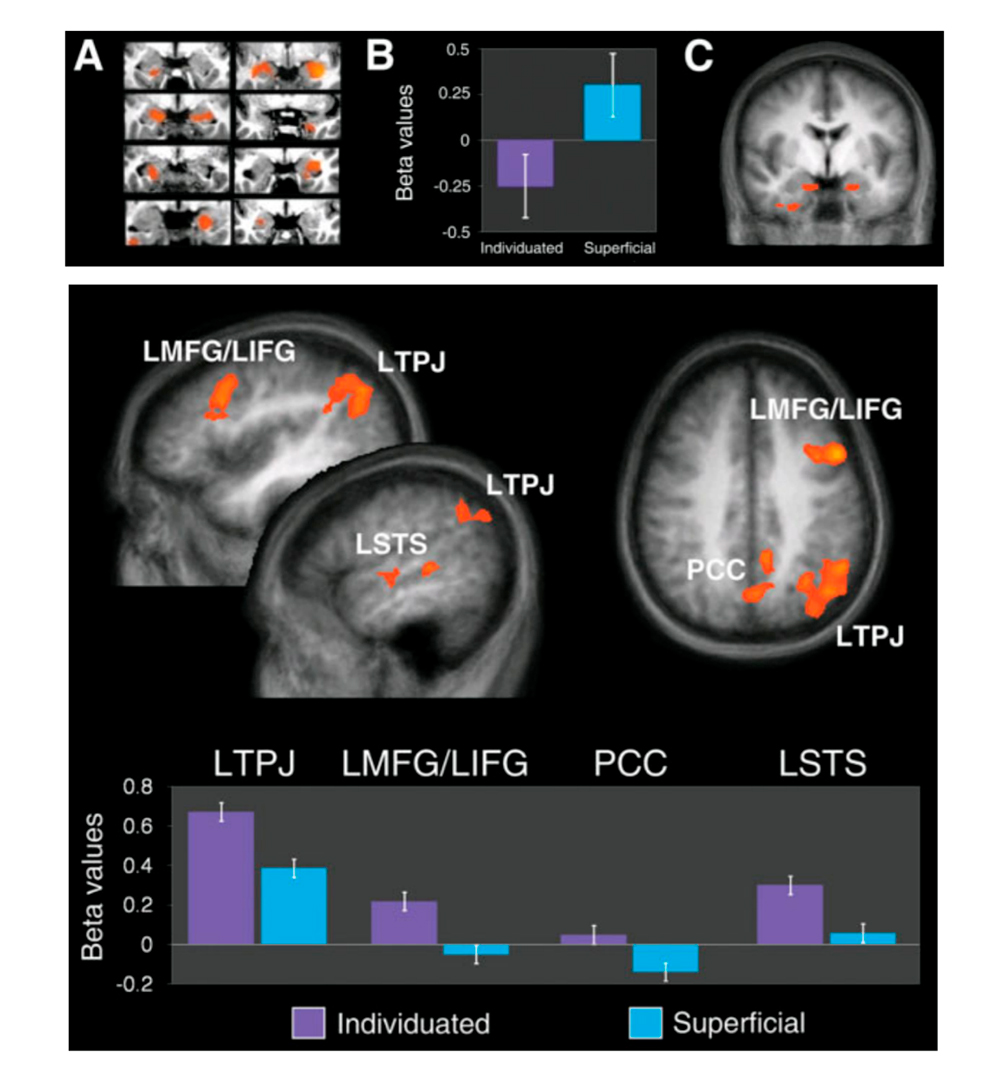
Above (B) The average activity of the tonsil is a blue column - corresponds to superficial judgments, individual purple. Below is a diagram of the activity of brain regions associated with personality modeling when performing similar tasks [27].
Fortunately, a biased reaction to skin color is not innate and depends on the social environment and the environment in which the formation of personality took place. And the evidence in favor of this was provided by a study in which the activation of the tonsil was checked for images of persons of a different race in 32 children aged 4 to 16 years. It turned out that tonsils were not activated on faces of another race, until about the time of puberty, while activation of tonsils on faces of another race was weaker if the child grew up in an environment with racial diversity [28].
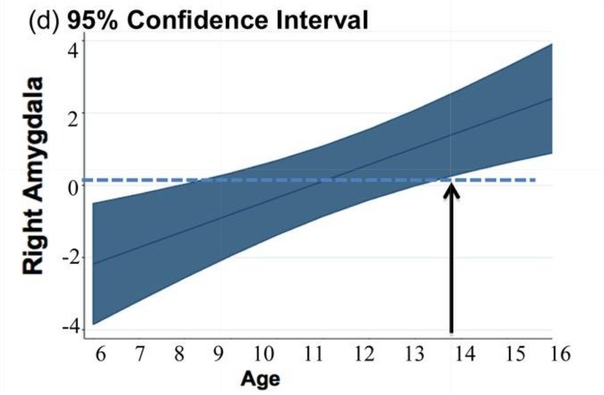
Tonsil activity on faces of another race, depending on age. Source: [28]
If we summarize all of the above, it turns out that our brain, being formed under the influence of childhood experience and the environment, can learn to recognize “dangerous” signs in the appearance of people and subsequently subconsciously affect our perception and behavior. So, having formed in an environment in which black people are considered dangerous strangers, your tonsil will give an alarming signal when you see a person with dark skin, even before you can logically assess the situation and make judgments about the personal qualities of this person, and In many cases, for example, when you need to make an instant decision or in the absence of other data, this can be critical.
[22] www.physiology.org/doi/full/10.1152/jn.00531.2012
[23] www.frontiersin.org/articles/10.3389/fpsyt.2018.00516/full
[24] www.ncbi.nlm.nih.gov/pmc/articles/PMC5460055
[25] www.ncbi.nlm.nih.gov/pubmed/11054916
[26] https://www.ncbi.nlm.nih.gov/pubmed/15563325/
[27] www.ncbi.nlm.nih.gov/pubmed/19618409
[28] www.ncbi.nlm.nih.gov/pmc/articles/PMC3628780
Fake kinship - real collaboration
So, on the one hand, we (people) have mechanisms for determining relatives that can be taught to work not at all on relatives, on the other hand, there are mechanisms for determining dangerous signs of a person that can also be subject to adjustment in the right direction and, as a rule, are more likely to respond to representatives external social groups. And the benefit here is obvious, communities with higher cooperation among their members have advantages compared to more disparate ones, and an increased level of aggression against external groups can help in the competition for resources.
Strengthening cooperation and altruism within a group is possible when its members perceive each other as larger relatives than they really are. Apparently, even a simple introduction of an appeal to members of the “brothers and sisters” community can create the effect of pseudo-kinship - numerous religious communities and sects can serve as an example of this.

Monks of one of the main Tibetan monasteries of Rato Dratsang. Source: en.wikipedia.org/wiki/Rato_Dratsang
Cases of the formation of pseudo-kin ties as a useful adaptation within ethnic groups of emigrants working in Korean restaurants are described [29], so the work collective, becoming a pseudo-family, receives advantages in the form of increased mutual assistance and cooperation.
And it is not surprising that this is exactly the way - “brothers and sisters” Stalin turned to the citizens of the USSR in his speech on July 3, 1941, urging him to go to war against the German troops [30].
[29] https://journals.sagepub.com/doi/abs/10.1177/1466138109347000
[30] https://topwar.ru/143885-bratya-i-sestry-obraschenie-iosifa-stalina-k-sovetskomu-narodu-3-iyulya-1941-goda.html
Inhuman cruelty
Communities of people from animals and other primates are distinguished by a great predisposition to cooperation, acts of altruism and empathy [31], which can serve as a barrier to the manifestation of aggression. The elimination of such barriers can increase aggressive behavior, one of the ways to remove the barriers can be dehumanization, because if the victim is not perceived as a person, then there will be no empathy.
Neuroimaging shows that when viewing photos of representatives of “extreme” social groups, such as homeless people or drug addicts, zones responsible for social perception are not activated in the brain [32], and this can create a vicious circle for people who have fallen into the “social bottom” because the more they go down the less people will be ready to help them.
A 2017 research team from Stanford published an article stating that anonymizing a victim increased aggression when gaining benefits, such as monetary rewards, depended on it. But on the other hand, when aggression was carried out according to moral criteria, for example, as a punishment for a crime, a description of the victim’s personal characteristics could even increase approval of the aggression [33].
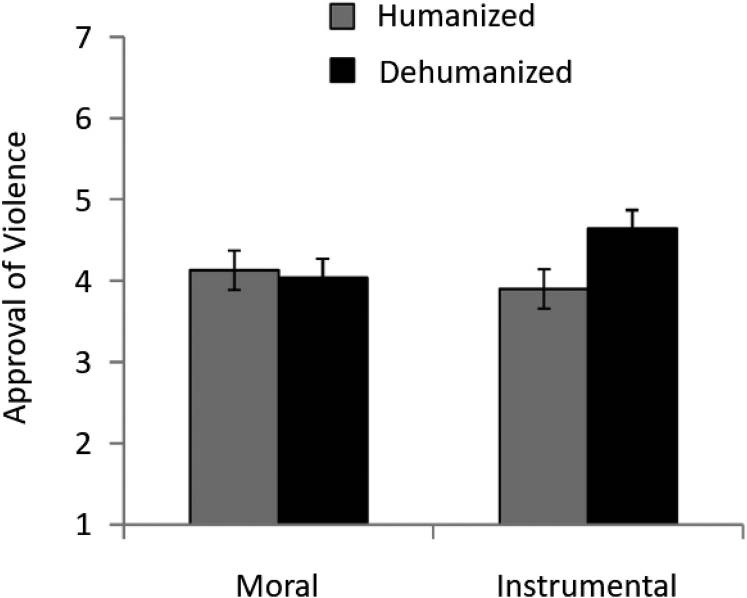
The average willingness of the subjects to harm a person depending on the motive; on the left, the moral motive on the right is gaining profit. The black columns correspond to the dehumanized description of the victim, the gray columns to the humanized description.
Historical examples of dehumanization mass. Almost every armed conflict can not do without propaganda using this classic technique, as an example we can cite examples of such propaganda from the beginning of the mid-20th century, produced during the civil and second world war in Russia. One can clearly see the pattern of creating an image of an enemy with signs of a dangerous animal, with claws and sharp fangs or a direct comparison with animals that cause hostility, such as a spider, which on the one hand should justify the use of violence and, on the other hand, reduce the level of empathy of the aggressor.

Examples of Soviet propaganda posters with dehumanization techniques. Source: my-ussr.ru
[31] royalsocietypublishing.org/doi/10.1098/rstb.2010.0118
[32] journals.sagepub.com/doi/full/10.1111/j.1467-9280.2006.01793.x
[33] https://www.pnas.org/content/114/32/8511
What's next?
Humans are an exclusively social biological species that forms complex interactions, both within groups and between them. We have an extremely high level of empathy and altruism and we can learn to perceive completely strangers as close relatives and empathize with someone else's grief as our own.
On the other hand, we are capable of extreme cruelty, mass killings and genocide, and we can just as easily learn to perceive our relatives as dangerous animals and exterminate them without experiencing moral contradictions.
Balancing between these two extremes, our civilization has not once experienced both blossoms and dark periods, and with the invention of nuclear weapons we have come closer than ever to the brink of complete mutual destruction.
And although this danger is now perceived more ordinary than at the height of the confrontation between the superpowers of the USA and the USSR, the catastrophe itself is still real, which confirms the assessment of the Doomsday Clock initiative, in which leading world scientists assess the likelihood of a global catastrophe in time format before midnight. And since 1991, the clock has been steadily approaching the fatal mark, having reached a maximum in 2018 and so far is still showing “two minutes to midnight” [34].
[34] thebulletin.org/doomsday-clock/past-statements

Fluctuations in the minute hand of the Doomsday Clock project as a result of various historical events, more about which can be found on the wikipedia page: en.wikipedia.org/wiki/Sudny_day Clock
The development of science and technology inevitably creates crises, the way out of which requires new knowledge and technology, and it seems that we have no other way of development than the path of knowledge. We live in an amazing time on the verge of breakthroughs in technologies such as quantum computers, thermonuclear energy and artificial intelligence - technologies that can take humanity to a whole new level and how we take advantage of these new opportunities will be decisive.
And in this light, it is difficult to overestimate the importance of research on the nature of aggression and cooperation, because they can provide important tips in finding answers to questions that are crucial for the future of humanity — how can we curb our aggression and learn to cooperate on a global scale in order to expand the concept of “our” to the entire population , not just individual groups.
Thanks for attention!
This review was written under the impression and in many respects using the materials of the lectures “Biology of Human Behavior” by the American neuroendocrinologist, Professor Robert Sapolsky, which he gave at Stanford University in 2010. The full course of lectures was translated into Russian by the Vert Dider project and is available in their group on the youtube channel www.youtube.com/watch?v=ik9t96SMtB0&list=PL8YZyma552VcePhq86dEkohvoTpWPuauk .
And for a better immersion in the topic, I recommend that you read the list of literature for this course in which everything is very conveniently sorted by topic: docs.google.com/document/d/1LW9CCHIlOGfZyIpowCvGD-lIfMFm7QkIuwqpKuSemCc